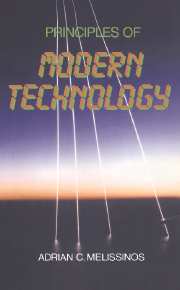Part A - Microelectronics and computers
Published online by Cambridge University Press: 03 December 2009
Summary
Microelectronics are found today at the heart of almost every device or machine. Be it an automobile, a cash register or just a digital watch it is controlled by electronic circuits built on small semiconductor chips. While the complexity of the functions performed by these devices has increased by several orders of magnitude their size is continuously decreasing. It is this remarkable achievement that has made possible the development of powerful processors and computers and has even raised the possibility of achieving artificial intelligence.
The basic building block of all microcircuits is the transistor, invented in 1948 by John Bardeen, Walter Brattain and William Shockley at Bell Telephone Laboratories. The first chapter is devoted to a discussion of the transistor beginning with a brief review of the structure of semiconductors and of the motion of charge carriers across junctions. We discuss the p–n junction and bipolar as well as field-effect transistors. We then consider modern techniques used in very large scale integration (VLSI) of circuit elements as exemplified by Metal-Oxide-Silicon (MOS) devices.
In the second chapter we take a broader look at how a processor, or computer, is organized and how it can be built out of individual logical circuit elements or gates. We review binary algebra and consider elementary circuits and the representation of data and of instructions; we also discuss the principles of mass data storage on magnetic devices. Finally we examine the architecture of a typical computer and analyze the sequence of operations in executing a particular task.
- Type
- Chapter
- Information
- Principles of Modern Technology , pp. 1 - 2Publisher: Cambridge University PressPrint publication year: 1990



